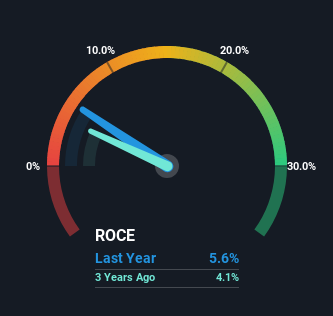- India
- /
- Metals and Mining
- /
- NSEI:MAHASTEEL
Mahamaya Steel Industries (NSE:MAHASTEEL) May Have Issues Allocating Its Capital
Ignoring the stock price of a company, what are the underlying trends that tell us a business is past the growth phase? Businesses in decline often have two underlying trends, firstly, a declining return on capital employed (ROCE) and a declining base of capital employed. This indicates to us that the business is not only shrinking the size of its net assets, but its returns are falling as well. In light of that, from a first glance at Mahamaya Steel Industries (NSE:MAHASTEEL), we've spotted some signs that it could be struggling, so let's investigate.
Return On Capital Employed (ROCE): What Is It?
For those that aren't sure what ROCE is, it measures the amount of pre-tax profits a company can generate from the capital employed in its business. Analysts use this formula to calculate it for Mahamaya Steel Industries:
Return on Capital Employed = Earnings Before Interest and Tax (EBIT) ÷ (Total Assets - Current Liabilities)
0.056 = ₹95m ÷ (₹2.5b - ₹769m) (Based on the trailing twelve months to December 2023).
So, Mahamaya Steel Industries has an ROCE of 5.6%. In absolute terms, that's a low return and it also under-performs the Metals and Mining industry average of 15%.
View our latest analysis for Mahamaya Steel Industries

While the past is not representative of the future, it can be helpful to know how a company has performed historically, which is why we have this chart above. If you'd like to look at how Mahamaya Steel Industries has performed in the past in other metrics, you can view this free graph of Mahamaya Steel Industries' past earnings, revenue and cash flow.
The Trend Of ROCE
In terms of Mahamaya Steel Industries' historical ROCE movements, the trend doesn't inspire confidence. About five years ago, returns on capital were 12%, however they're now substantially lower than that as we saw above. Meanwhile, capital employed in the business has stayed roughly the flat over the period. Since returns are falling and the business has the same amount of assets employed, this can suggest it's a mature business that hasn't had much growth in the last five years. So because these trends aren't typically conducive to creating a multi-bagger, we wouldn't hold our breath on Mahamaya Steel Industries becoming one if things continue as they have.
What We Can Learn From Mahamaya Steel Industries' ROCE
In the end, the trend of lower returns on the same amount of capital isn't typically an indication that we're looking at a growth stock. It should come as no surprise then that the stock has fallen 25% over the last five years, so it looks like investors are recognizing these changes. Unless there is a shift to a more positive trajectory in these metrics, we would look elsewhere.
On a final note, we found 2 warning signs for Mahamaya Steel Industries (1 is concerning) you should be aware of.
For those who like to invest in solid companies, check out this free list of companies with solid balance sheets and high returns on equity.
New: Manage All Your Stock Portfolios in One Place
We've created the ultimate portfolio companion for stock investors, and it's free.
• Connect an unlimited number of Portfolios and see your total in one currency
• Be alerted to new Warning Signs or Risks via email or mobile
• Track the Fair Value of your stocks
Have feedback on this article? Concerned about the content? Get in touch with us directly. Alternatively, email editorial-team (at) simplywallst.com.
This article by Simply Wall St is general in nature. We provide commentary based on historical data and analyst forecasts only using an unbiased methodology and our articles are not intended to be financial advice. It does not constitute a recommendation to buy or sell any stock, and does not take account of your objectives, or your financial situation. We aim to bring you long-term focused analysis driven by fundamental data. Note that our analysis may not factor in the latest price-sensitive company announcements or qualitative material. Simply Wall St has no position in any stocks mentioned.
About NSEI:MAHASTEEL
Mahamaya Steel Industries
Engages in the manufacture and sale of steel structures products in India.
Solid track record with adequate balance sheet.
Similar Companies
Market Insights
Community Narratives



